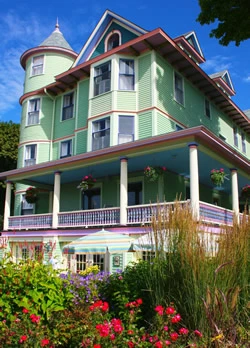French Influence on Mackinac Island: A Cultural Snapshot
Beginnings and Historical Foundations
There is more to Mackinac Island than just a beautiful vacation spot. Beneath its allure is a tale influenced by numerous cultures. Among them, the French left a lasting mark. Their arrival changed the island’s history, traditions, and even its name.
The French Arrive: A Historical Backdrop
In the 1600s, French explorers set out across the Great Lakes. They came in search of trade, land, and new opportunities. Mackinac Island, sitting between Lake Huron and Lake Michigan, was a key location.
The French saw the island’s value early on. It developed into a fur trade powerhouse. They built trading posts, missions, and forts. These structures helped them connect with local Native tribes.
The French also brought Catholic missionaries. These missionaries worked to spread their faith and build community ties. Over time, the island became a mix of French and Native cultures.
Lingering Legacies: French Names and Landmarks
Many names on the island have French roots. Even the name “Mackinac” comes from the French spelling of “Michilimackinac.” This word was based on the Ojibwe name for the area.
You can still find French influence in:
- Place names such as Cheboygan and Bois Blanc Island
- Historical markers that tell stories of French explorers
- The design of early forts and mission sites reflects the island’s French roots.
Some of these sites have been preserved for visitors today. Fort Michilimackinac, although now located in Mackinaw City, tells part of this early story.
French culture touched more than just names. It shaped early life on the island. Their peaceful trade with Native tribes allowed for cultural exchange. French customs, language, and ideas took root.
This early history gave Mackinac its unique character. It wasn’t just a trade stop—it became a meeting place of cultures. French influence set the stage for what the island would become.
Cultural Imprints and Community Life
The French didn’t just trade on Mackinac Island. They left behind styles, customs, and ways of life. These cultural touches shaped how the island looks and feels today. You can still spot signs of French influence across the island’s streets, buildings, and traditions.
Cultural Imprints in Architecture & Design
French settlers brought their building styles with them. While many early structures are gone, their ideas remain. You can still see hints of French Colonial design across the island.
These touches include:
- Wide porches and steep roofs
- Simple woodwork and long, narrow windows
- Homes built close together, forming walkable neighborhoods
Many older homes and inns use these design elements. They reflect the French focus on community and comfort. Some of these homes have been carefully restored to honor the past.
Buildings around the island’s historic district still carry this charm. Even newer buildings sometimes echo this French style. Together, they give Mackinac its cozy, storybook feel.
French Influence on Food and Lifestyle
Food tells its own story. French settlers brought new cooking styles and recipes. While modern menus are different, traces of French influence can still be found.
Early meals on the island combined French and Native traditions. French stews, fish dishes, and bread were often shared with local tribes. They used fresh herbs, local game, and lake fish. These simple meals were rich in flavor and tradition.
Today, a few restaurants on or near the island offer:
- Crêpes or French toast on breakfast menus
- Herb-based sauces and slow-cooked dishes inspired by French cooking
- Cheese, wine, and pastry options that nod to French tastes
Gatherings were important to the French way of life, even beyond eating. Friends and families often shared meals, stories, and laughter. That spirit is still felt in Mackinac’s warm, welcoming vibe.
Legacy and Living History
Mackinac Island is more than a tourist destination. It’s a living piece of history. The French continue to have a strong yet subtle effect. From early Native alliances to present-day museums, the French spirit still echoes across the island.
French–Native American Relations
When the French arrived, they didn’t just build forts and trade. They built relationships. French settlers worked closely with the Odawa and Ojibwe tribes. These groups had lived around the Great Lakes for centuries.
Unlike some later settlers, the French aimed for peace. They traded goods and shared food, tools, and knowledge. They respected the tribes’ role in the fur trade and learned their customs.
Over time, the French and Native peoples formed deeper connections. Some married and started families. These families became known as Métis—people of mixed French and Native heritage.
The Métis helped both groups understand each other better. They spoke both languages and followed both traditions. Their presence became a key part of Mackinac’s early society.
The blending of cultures created:
- Shared festivals and seasonal gatherings
- Traditional crafts combining French and Native designs
- Family connections and community spirit were at the heart of daily life.
This cultural mix helped form the island’s unique identity.
Today’s Cultural Reflection: Where the French Spirit Lives On
Even today, you can still feel the French roots of Mackinac. Museums, plaques, and historic tours tell stories from this early era.
Visitors can explore:
- Fort Mackinac, which replaced earlier French forts
- Mission Church stands as one of the island’s most historic structures.
- Interpretive signs that explain French and Native connections
Local museums often highlight the French role in shaping island life. Exhibits share the stories of traders, families, and early settlers. You might also spot reenactors in period dress during summer months.
Some cultural events and walking tours include:
- Fur trade demonstrations
- Talks on Métis heritage
- Seasonal festivals with historical themes
Many inns and shops also honor the island’s past in subtle ways. From the French-style architecture to the names on menus, the legacy remains.
Conclusion
Mackinac Island is shaped by many cultures—but the French played a major role. They left behind more than names or buildings. They helped build a way of life.
From shared meals to family stories, the French spirit still lives on. It’s woven into the island’s charm, ready to be discovered by every visitor.
To truly enjoy this rich history and beauty, consider staying at the Inn on Mackinac. With its historic charm and welcoming atmosphere, it’s the perfect place to relax while exploring the island’s French legacy.
Category: Mackinac Island


